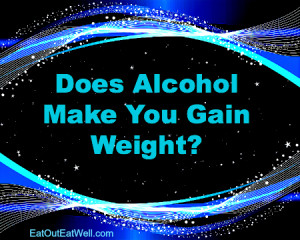It certainly can. Pure alcohol, gram for gram, has almost twice the number of calories as a gram of carbohydrate or protein. One gram of alcohol has 7 calories compared to the 4 calories for carbohydrate or protein – fat has nine calories a gram. Some research is showing that calories from alcohol may be burned less efficiently, but the calories still pack a punch.
There’s another factor, too. If you drink alcohol along with your other daily food, you’re often adding, not replacing, the calories from other food or drinks. If everything else stays the same, you’ll gain weight. And, alcohol can cause disinhibition — it reduces your ability manage your immediate impulsive response to a situation – in other words, it makes you less focused on how much you’re eating.
However, statistically, drinkers aren’t more likely to be obese than nondrinkers. But a number if factors come into play: the amount and type of alcohol; when, where, and the type of drinking pattern; the way your body processes the alcohol; and various psychological factors.
Gender Differences On Drinking Days
A study in the American Journal of Clinical Nutrition compared the food and calorie intake of 1,864 people on days when they did and didn’t drink. On drinking days men (including 10% who were heavy drinkers which would skew the numbers higher) averaged 433 extra calories; 363 of them came from alcohol, the rest from extra food and other kinds of beverages. The men also ate more protein, fat, salt, and meat on drinking days.
Women averaged an extra 299 calories on drinking days, almost all of them coming from alcohol. Although they didn’t eat much more than on nondrinking days, they did eat more fat and less healthy foods.
Good News, Bad News
About 35% of American adults don’t drink, 55% are light or moderate drinkers, and 10% drink more than a moderate amount. It’s estimated that alcohol directly or indirectly causes 90,000 deaths a year in the US, including more than 11,000 traffic fatalities.
But drinking has benefits, too It can be part of social, business and family life and regular drinking, even in small amounts, decreases the risk of cardiovascular disease. Alcohol, like aspirin, reduces blood clotting — a transient effect that lasts for about a day. Alcohol can raise HDL (“good”) cholesterol levels over time and moderate intake helps to reduce the risk of other health problems, including type 2 diabetes, gallstones, peripheral artery disease, and perhaps dementia.
The most serious health risks — alcoholism, heart and liver disease, hypertension, certain cancers, osteoporosis, car crashes and other accidents — come mostly from heavy drinking, but moderate drinking can affect your coordination and ability to drive, operate machinery, or swim.
If You’re Going To Drink, Should You Do It Every Day?
It seems that drinking small amounts regularly and with meals (it slows the absorption of the alcohol) is better than occasionally drinking larger amounts. Some research findings suggest that daily (or almost daily) drinking is best for the heart; other studies have found that drinking every other day is enough to get benefits; and still others have found that it only takes half a standard drink a day. (In the US a “drink” is 5 ounces of wine, 12 ounces of beer, or 1.5 ounces of 80-proof liquor, which all contain about 14 grams of pure alcohol.)
What’s Moderate Drinking?
In the US, moderate drinking — as defined in the Dietary Guidelines for Americans — is up to one drink a day for a woman and up to two for a man. (Other countries define moderation and the size of a “standard” drink differently.) The recommended amount is less for women because they tend to be smaller, have proportionately more body fat, and have less body water (alcohol is diluted in body water). Generally, the same amount of alcohol would cause higher blood level of alcohol in women than in men and would also cause more impairment.


Leave a Reply